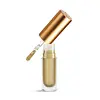What's inside
What's inside
 Key Ingredients
Key Ingredients

 Benefits
Benefits

 Concerns
Concerns

 Ingredients Side-by-side
Ingredients Side-by-side

Water
Skin ConditioningSynthetic Fluorphlogopite
CI 77891
Cosmetic ColorantAlcohol Denat.
AntimicrobialIsohexadecane
EmollientPropylene Glycol
HumectantMica
Cosmetic ColorantButylene Glycol
HumectantHexylene Glycol
EmulsifyingAcrylamide/Sodium Acryloyldimethyltaurate Copolymer
Emulsion StabilisingPhenoxyethanol
PreservativeHydrogenated Styrene/Isoprene Copolymer
Isododecane
EmollientAcrylic Acid/Isobutyl Acrylate/Isobornyl Acrylate Copolymer
CI 77510
Cosmetic ColorantPolysorbate 80
EmulsifyingDisodium EDTA
CI 77288
Cosmetic ColorantSorbitan Oleate
EmulsifyingCaffeine
Skin ConditioningAscorbyl Glucoside
AntioxidantGlycerin
HumectantPentaerythrityl Tetra-Di-T-Butyl Hydroxyhydrocinnamate
AntioxidantCarica Papaya Fruit Extract
Skin ConditioningPotassium Sorbate
PreservativeWater, Synthetic Fluorphlogopite, CI 77891, Alcohol Denat., Isohexadecane, Propylene Glycol, Mica, Butylene Glycol, Hexylene Glycol, Acrylamide/Sodium Acryloyldimethyltaurate Copolymer, Phenoxyethanol, Hydrogenated Styrene/Isoprene Copolymer, Isododecane, Acrylic Acid/Isobutyl Acrylate/Isobornyl Acrylate Copolymer, CI 77510, Polysorbate 80, Disodium EDTA, CI 77288, Sorbitan Oleate, Caffeine, Ascorbyl Glucoside, Glycerin, Pentaerythrityl Tetra-Di-T-Butyl Hydroxyhydrocinnamate, Carica Papaya Fruit Extract, Potassium Sorbate
Water
Skin ConditioningSynthetic Fluorphlogopite
Butylene Glycol
HumectantSqualane
EmollientHdi/Trimethylol Hexyllactone Crosspolymer
Methyl Methacrylate Crosspolymer
Vp/Hexadecene Copolymer
Mica
Cosmetic ColorantSorbeth-30 Tetraisostearate
EmulsifyingPropylene Glycol
HumectantPhenoxyethanol
PreservativeBenzyl Alcohol
PerfumingOctyldodecanol
EmollientEthylhexylglycerin
Skin ConditioningSorbitan Sesquiisostearate
EmulsifyingAcrylates/Beheneth-25 Methacrylate Copolymer
PPG-8-Ceteth-20
EmulsifyingPotassium Hydroxide
BufferingDehydroacetic Acid
PreservativeAminomethyl Propanol
BufferingActinidia Polygama Fruit Extract
Skin ConditioningSodium Lauryl Sulfate
CleansingSodium Benzoate
MaskingTocopherol
AntioxidantCI 77891
Cosmetic ColorantIron Oxides
CI 77491
Cosmetic ColorantCI 77499
Cosmetic ColorantWater, Synthetic Fluorphlogopite, Butylene Glycol, Squalane, Hdi/Trimethylol Hexyllactone Crosspolymer, Methyl Methacrylate Crosspolymer, Vp/Hexadecene Copolymer, Mica, Sorbeth-30 Tetraisostearate, Propylene Glycol, Phenoxyethanol, Benzyl Alcohol, Octyldodecanol, Ethylhexylglycerin, Sorbitan Sesquiisostearate, Acrylates/Beheneth-25 Methacrylate Copolymer, PPG-8-Ceteth-20, Potassium Hydroxide, Dehydroacetic Acid, Aminomethyl Propanol, Actinidia Polygama Fruit Extract, Sodium Lauryl Sulfate, Sodium Benzoate, Tocopherol, CI 77891, Iron Oxides, CI 77491, CI 77499
Ingredients Explained
These ingredients are found in both products.
Ingredients higher up in an ingredient list are typically present in a larger amount.
Butylene Glycol (or BG) is used within cosmetic products for a few different reasons:
Overall, Butylene Glycol is a safe and well-rounded ingredient that works well with other ingredients.
Though this ingredient works well with most skin types, some people with sensitive skin may experience a reaction such as allergic rashes, closed comedones, or itchiness.
Learn more about Butylene GlycolCi 77891 is a white pigment from Titanium dioxide. It is naturally found in minerals such as rutile and ilmenite.
It's main function is to add a white color to cosmetics. It can also be mixed with other colors to create different shades.
Ci 77891 is commonly found in sunscreens due to its ability to block UV rays.
Learn more about CI 77891Mica is a naturally occurring mineral used to add shimmer and color in cosmetics. It can also help improve the texture of a product or give it an opaque, white/silver color.
Serecite is the name for very fine but ragged grains of mica.
This ingredient is often coated with metal oxides like titanium dioxide. Trace amounts of heavy metals may be found in mica, but these metals are not harmful in our personal products.
Mica has been used since prehistoric times throughout the world. Ancient Egyptian, Indian, Greek, Roman, Aztec, and Chinese civilizations have used mica.
Learn more about MicaPhenoxyethanol is a preservative that has germicide, antimicrobial, and aromatic properties. Studies show that phenoxyethanol can prevent microbial growth. By itself, it has a scent that is similar to that of a rose.
It's often used in formulations along with Caprylyl Glycol to preserve the shelf life of products.
Propylene Glycol is an odorless, colorless liquid. As a humectant, it helps skin retain moisture. It also aids in delivering active ingredients.
Another role of this ingredient is preventing a product from melting or freezing. Propylene glycol also adds antimicrobrial properties to a product, elongating product lifespan.
This ingredient is considered an organic alcohol and commonly added into both cosmetics and foods.
Those with sensitive skin or conditions may develop a rash when using this ingredient.
Learn more about Propylene GlycolSynthetic Fluorphlogopite is the synthethic version of mica. It consists of fluorine, aluminum and silicate.
Synthetic Fluorphlogopite is used to add volume to products.
It is considered non-irritating on the skin.
Learn more about Synthetic FluorphlogopiteWater. It's the most common cosmetic ingredient of all. You'll usually see it at the top of ingredient lists, meaning that it makes up the largest part of the product.
So why is it so popular? Water most often acts as a solvent - this means that it helps dissolve other ingredients into the formulation.
You'll also recognize water as that liquid we all need to stay alive. If you see this, drink a glass of water. Stay hydrated!
Learn more about Water